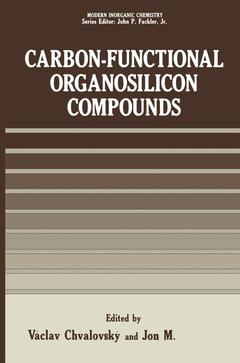Description
Carbon-Functional Organosilicon Compounds, Softcover reprint of the original 1st ed. 1984
Modern Inorganic Chemistry Series
Coordinator: Chvalovsky Vaclav
Language: English
Subject for Carbon-Functional Organosilicon Compounds:
Keywords
bonding; carbon; chemical bond; chemistry; chromatography; metals; phosphorus; polymer; silicon; spectroscopy; synthesis
Publication date: 12-2012
303 p. · 15.2x22.9 cm · Paperback
303 p. · 15.2x22.9 cm · Paperback
Description
/li>Contents
/li>
The term "carbon-functional organosilicon compound" is used for organosilicon compounds in which a functional group is bonded to an organic moiety that is in turn con nected to silicon via a Si-C bond. Thus, only Si-Cn-Y com pounds (Y designates a functional group) will be discussed in this book 1 Si-O-Cn-Y compounds will in general not be considered, although the latter group does include a large number of natural substances containing silylated hydroxyl groups. (Because of the differing importance of various Y groups, the reader will find some deviation from this restriction). Finally, compounds containing a silyl group as the functional group are not considered. An overview of the field of organosilicon chemistry would show that in the last several decades the commercial synthesis of organosilicon products has increased substan tially, both in annual production and also in the increasing variety of compounds produced. This increase in the number of commercially available carbon-functional monomers and polymers (silicone polymers) is most remarkable and is occurring because new applications are continually being found for these compounds. As might be expected, the number of publications in this field is also increasing. The important position of silicon in the periodic table - between carbon, aluminum, and phosphorus - means that an understanding of the nature of the bonds in organosilicon compounds is quite important in order to understand the bonding in these other areas.
1. Some Applications of Carbon-Functional Organosilicon Compounds.- 1.1 Introduction.- 1.2 The Production of Carbon-Functional Organosilicon Compounds.- 1.3 Uses as Derivatizing Agents for Natural Substances.- 1.4 Uses as Stationary Phases for Gas-Liquid Chromatography.- 1.5 Uses in Surface Treatment of Inorganic Materials.- 1.5.1 As Coupling Agents for Inorganic Fillers of Polymers.- 1.5.2 For Immobilization of Peptides and Proteins on Solid Carriers.- 1.5.3 For Immobilization of Metal Complex Catalysts.- 1.6 References.- 2. Intramolecular Interaction in The Chemical Behavior of Carbon-Functional Organosilicon Compounds.- 2.1 Introduction.- 2.2 Substituent Effects of Silyl Groups in Organic Reactions.- 2.2.1 Reactions of Organometallic Compounds.- 2.2.2 Reactions of Alkenes.- 2.2.3 Reactions of Aromatic Compounds.- 2.2.4 Reactions of Compounds with Keto, Carboxyl, and Carbalkoxyl Groups.- 2.2.5 Reactions of Amines.- 2.2.6 Reactions of Alcohols, and Their Esters, Acetais, and Ethers.- 2.2.7 Reactions of Thiols and Sulfides.- 2.2.8 Reactions of Alkyl Halides.- 2.3 Reactions with Pathway Dominated by Through-Space Interaction Between Silicon and A Functional Group.- 2.3.1 Reactions Involving 1,2-Interaction.- 2.3.2 Reactions Involving 1,3-Interaction.- 2.3.3 Reactions Involving 1,4-Interaction.- 2.3.4 Reactions Involving 1,5- or 1,6-Interaction.- 2.4 References.- 3. NMR Spectroscopy in The Investigation and Analysis of Carbon-Functional Organosilicon Compounds.- 3.1 Introduction.- 3.2 29Si NMR Spectroscopy.- 3.2.1 Experimental Aspects.- 3.2.2 29Si Chemical Shifts - Basic Facts.- 3.2.3 29Si Shielding Theory and Model.- 3.2.4 29Si Spin-Spin Coupling Constants.- 3.3 Aliphatic Carbon-Functional Compounds.- 3.3.1 1H NMR Spectroscopy.- 3.3.2 13C NMR Spectroscopy.- 3.3.3 29Si NMR Spectroscopy.- 3.3.4 Typical Results.- 3.4 Aromatic Carbon-Functional Compounds.- 3.4.1 NMR Spectroscopy of Functional Groups.- 3.4.2 NMR Spectroscopy of Silyl Groups SiX1X2X3.- 3.4.3 NMR Spectroscopy of the Connecting Chain.- 3.5 Conclusions.- 3.6 References.- 4. Theoretical Aspects of Bonding in Organosilicon Chemistry.- 4.1 Introduction.- 4.2 Valence Shell Expansion from The Point of View of Quantum Theory.- 4.2.1 The Concept of Orbitals.- 4.2.2 Classification of Atomic Orbitals.- 4.2.3 Transformation Properties of d Orbitals.- 4.2.4 d Orbitals and Hybridization.- 4.2.5 Other Factors Influencing the Utilization of d Orbitals in Bonding.- 4.2.6 The Variational Principle and d Orbital Participation.- 4.3 Hyperconjugation.- 4.3.1 General Introduction.- 4.3.2 Hyperconjugation in Organosilicon Chemistry.- 4.3.3 Theoretical Aspects of Hyperconjugation.- 4.3.4 Hyperconjugation and the Accuracy of a Localized Description of Bonding.- 4.4 Electronegativity.- 4.5 Electronic Effects of Silyl Substituents and The Possibilities of Their Characterization.- 4.5.1 Linear Free Energy Relationships.- 4.5.2 Fourier Component Analysis of Internal Rotation.- 4.5.3 The ?-Effect and Acid-Base Properties.- 4.6 The Chemistry of Silicenium Ions and Silyl Anions.- 4.6.1 Silicenium Ions.- 4.6.2 Silyl Anions.- 4.7 Common Aspects of Chemical Reactivity of Carbon-Functional Organosilicon Compounds.- 4.8 The Chemistry of Multiple Bonded Silicon.- 4.9 Conclusions.- 4.10 Acknowledgment.- 4.11 References.
© 2024 LAVOISIER S.A.S.




